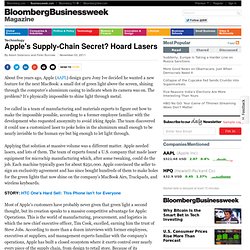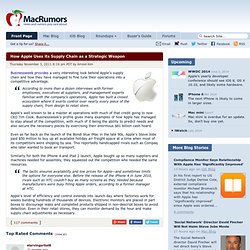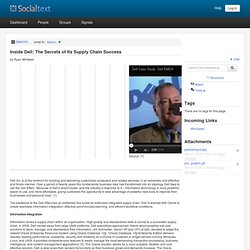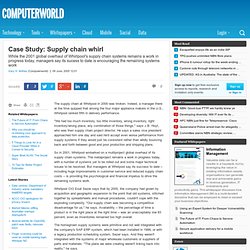

Case Studies — Supply Chain Programme. Apple's Supply-Chain Secret? Hoard Lasers. About five years ago, Apple (AAPL) design guru Jony Ive decided he wanted a new feature for the next MacBook: a small dot of green light above the screen, shining through the computer’s aluminum casing to indicate when its camera was on.

The problem? It’s physically impossible to shine light through metal. Ive called in a team of manufacturing and materials experts to figure out how to make the impossible possible, according to a former employee familiar with the development who requested anonymity to avoid irking Apple. The team discovered it could use a customized laser to poke holes in the aluminum small enough to be nearly invisible to the human eye but big enough to let light through. Applying that solution at massive volume was a different matter. Most of Apple’s customers have probably never given that green light a second thought, but its creation speaks to a massive competitive advantage for Apple: Operations. Not every supplier gives in. How Apple Uses its Supply Chain as a Strategic Weapon. Businessweek provides a very interesting look behind Apple's supply chain and how they have managed to fine tune their operations into a competitive advantage.

According to more than a dozen interviews with former employees, executives at suppliers, and management experts familiar with the company’s operations, Apple has built a closed ecosystem where it exerts control over nearly every piece of the supply chain, from design to retail store. Apple's well known to be a master at operations with much of that credit going to now CEO Tim Cook. Businessweek's profile gives many examples of how Apple has managed to stay ahead of the competition, with much of it being the ability to predict needs and also secure the necessary pieces by exercising their enormous $81 billion cash hoard. Similarly for both the iPhone 4 and iPad 2 launch, Apple bought up so many suppliers and machines needed for assembly, they squeezed out the competition who needed the same resources. Supplier Responsibility. Inside Dell: The Secrets of Its Supply Chain Success / ISM4300. By Ryan Whitaker Source: (7) Dell Inc. is at the forefront for building and delivering customized computers and related services, in an extremely cost effective and timely manner.

Over a period of twenty years this fundamental business idea has transformed into an ideology Dell likes to call the Dell Effect. “Because of Dell’s direct model- and the industry’s response to it – information technology is more powerful, easier to use, and more affordable, giving customers the opportunity to take advantage of powerful new tools to improve their businesses and personal lives.” (1) The backbone to the Dell Effect lies an extremely fine tuned an extensive integrated supply chain. Information Integration Information drives a supply chain within an organization. Source: (6) Synchronized Planning After establishing information standards, successful supply chain managers and their industry partners must establish methodologies to plan, forecast, and replenish necessary resources.
Source: (4) Case Study: Supply chain whirl. The supply chain at Whirlpool in 2000 was broken.

Indeed, a manager there at the time quipped that among the four major appliance makers in the U.S., Whirlpool ranked fifth in delivery performance. "We had too much inventory, too little inventory, wrong inventory, right inventory/wrong place, any combination of those things," says J.B. Hoyt, who was then supply chain project director. He says a sales vice president approached him one day and said he'd accept even worse performance from supply systems if they would just be consistent rather than wildly bouncing back and forth between good and poor production and shipping plans. So in 2001, Whirlpool embarked on a multiproject global overhaul of its supply chain systems. Whirlpool CIO Esat Sezer says that by 2000, the company had grown by acquisition and geographic expansion to the point that old systems, stitched together by spreadsheets and manual procedures, couldn't cope with the exploding complexity.
Learning From Toyota. DSpace@MIT : An analysis of current supply chain best practices in the retail industry with case studies of Wal-Mart and Amazon.com. Amazon Case Analysis. Wal-Mart's supply chain management. Supply Chain of Coca-Cola. Supply Chain Management Of Worlds Famous Clothing Company. Case study: Zara's Vertical Supply Chain. Www.gsb.stanford.edu/scforum/login/documents/OIT71.pdf.